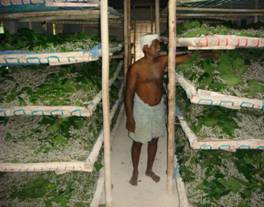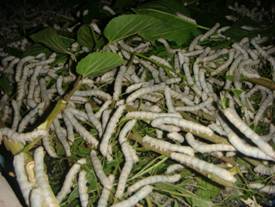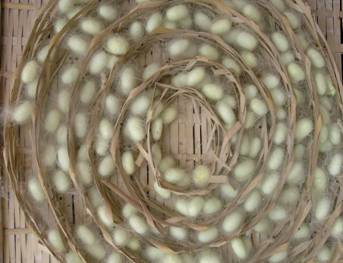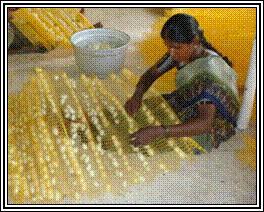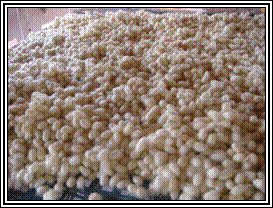LATE AGE SILKWORM REARING
-
The third, fourth and fifth instar larvae are considered as late age worms. They are reared in bamboo trays. Newspapers are spread over the trays to absorb excess moisture in leaves and faecal pellets.
-
The temperature and humidity requirement gradually comes down as the stage advances.
-
Leaves of medium maturity (6th leaf onwards) are fed in the third and fourth age and coarse leaves are fed in the fifth age.
-
Over matured and yellow leaves should be rejected, since they may induce disease outbreak.
Bed disinfectants
Apply bed disinfectants like TNAU Seridust, Resham Jyothi, Vijetha or Sajeevini @ 4 kgs/100 dfls.
Stage (before feeding) |
Bed disinfectant (Qty/100 dfls) (g) |
After 1st moult |
50 |
After 2nd moult |
150 |
After 3rd moult |
800 |
After 4th moult |
1000 |
On fourth day of final instar |
2000 |
Total |
4000 |
Moulting
- Remove the paraffin papers
- Evenly spread the larvae in the rearing bed 6-8 h before settling for moult.
- Provide air circulation to avoid excess humidity inside the room.
- Provide charcoal stove/heaters to raise the room temperature during winter.
- Apply lime powder at 60 minutes before resumption of feeding daily during rainy/winter seasons to reduce the dampness in bamboo trays.
Mounting
- Apply Sampoorna @ 20 ml (dissolved in 4 l of water) per 100 dfls over the leaves for early and uniform spinning of cocoons.
- After attaining full growth in the final instar, the worms cease to feed and are ready to spin.
- Such worms are slightly translucent and raise their heads to find a place for spinning.
- These worms have to be picked up and transferred to a mountage for spinning cocoons.
- Mounting of worms should not be delayed as the ripened worms will waste silk.
- About 800-900 worms per m2 are to be kept on a mountage. For 100 dfls, about 30 to 40 chandrakis are required.
- Mountages should be kept under shade in well ventilated place.
Care during spinning
-
Quality of silk depends on the care taken at the time of spinning.
-
Mature worms are sensitive to temperature, humidity, light, etc., at the time of spinning.
-
The ripe worm requires space equal in area to square of the length of its body for spinning.
-
Proper spacing avoids wastage of silk for forming preliminary web and avoids double cocoons.
-
To prevent staining of cocoons, keep mountage in an inclined position so that the urine may drop to the ground.
Maintenance of humidity
- Fluctuation of humidity causes abrupt thinning and thickening of silk filament.
- A relative humidity of 60-70% is ideal for spinning.
- Provide proper ventilation and straw mats below the mountage to quid excreta.
- Provide even and moderate lighting. Improper lighting (bright light or dark shadow) causes crowding of larvae to shaded area leading to double cocoons.
- Remove dead worms and non-spinners on the 2nd day of spinning.
- To protect the silkworm from predatory ants, apply malathion 5% dust/lakshman rekha at the base of mountage stand.
Harvesting
-
The silk worms complete spinning in 2 to 3 days but the cocoons should not be harvested at this time as the worms inside are still in the prepupal stage.
-
Harvesting should be done on the fifth day (7th day for bivoltine hybrids) when pupae are fully formed and hard.
-
Do not harvest when the pupa is in amber colour.
-
Dead and diseased worms on the mountages should be removed before harvest.
-
Marketing of cocoons should be done on the sixth day (8th day for bivoltine hybrids).
Shoot rearing for late age worms
Silkworm larvae consume 85% of their food requirement during fifth instar. Fifty per cent of the labour input is utilized during the last seven days of rearing.
Rearing house
- Provide separate rearing house for shoot rearing in shady areas. Separate room should be provided for young age worm rearing, leaf storing and hall for late age worm rearing.
Shoot rearing rack
- A rearing rack of 1.2m x 11m size is sufficient to rear 50 dfls.
- Provide 15 cm border on all sides of the shelf to prevent the migration of the larvae.
- Arrange the shelves in three tier system with 50 cm space between the tiers.
- Fabricate the rack stand with wood, or steel and the rearing seat with wire mesh/bamboo mat.
Shoot harvesting
- Harvest the shoots at 1 m height from ground level at 60 to 70 days after pruning.
- Store the shoots vertically upwards in dark cooler room.
- Provide thin layer of water (3 cm) in one corner of storage room and place the cut of shoots in the water for moisture retention.
Feeding
- Provide a layer of newspaper in rearing shelf.
- Disinfect the bed, spread the shoot in perpendicular to width of the bed.
- Place top and bottom ends of the shoots alternatively to ensure equal mixing of different qualities of leaves.
- Transfer the third instar larvae to shoots immediately after moulting.
- Watch for feeding rate from 4th day of fourth instar. If 90% of larvae have not settled for moulting, provide one or two extra feedings.
- Provide 3 feedings during rainy/winter months and 4 feedings during summer rearing.
Spacing
Bed cleaning
- Bed cleaning is done once during second day of fifth instar following rope (or) net method.
- In rope method, spread 2 m length of rope (two numbers) at parallel row leaving 0.5m on other side.
- After 2 to 3 feedings, ends of the ropes are pulled to the centre to make it into a bundle.
- In net cleaning method, spread 1.5 cm2 size net across the bed.
- After 2 or 3 feedings, the nets are lifted and the old bed is cleaned and disinfected.
- Transfer the net to newer shelf, spread the net over the shoots; larvae will migrate to lower layer.
Advantages
1. Labour saving upto 70% when compared on hour to hour basis with leaf feeding method.
2. Leaf saving upto 15-20%. Hence, leaf cocoon ratio is less by 2-3 kg and extra cocoon production.
3. Better cocoon characters and effective rate of rearing (ERR).
4. Better preservation of leaf quality both during storing and on the bed.
5. More organic matter production (upto 18 tonnes per ha per year).
6. Better hygienic conditions can be maintained.
7. Handling of silkworms minimised. Hence, contamination and spreading of disease reduced.
8. Bed cleaning only once after IV moult.
9. Worms and leaves are kept away from the litter. Hence, chances of secondary contamination are minimised.
10. Labour dependent risk is reduced.
Disadvantages
1. Required rearing room floor area is more (by 30%)
2. Bed refusals will not be available as a cattle feed.
3. Planting materials (cuttings) will not be available. |

